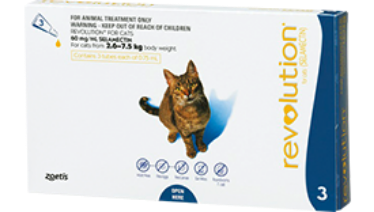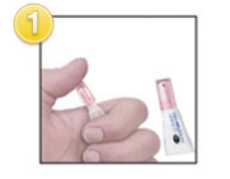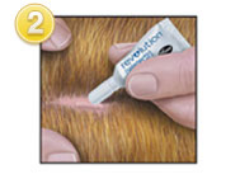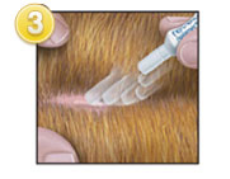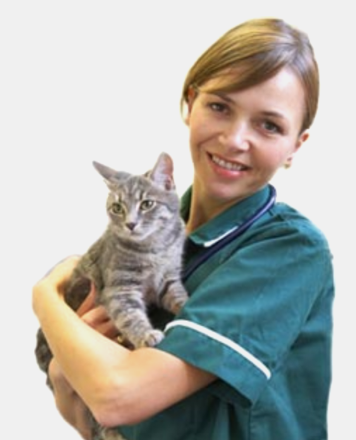- Want to Buy Revolution?USE OUR VET FINDER TOOL
-
REVOLUTION FOR CATS
 SEE REVOLUTION
SEE REVOLUTION
FLEA FOR DOGS
ABOUT REVOLUTION
Providing Parasite Protection
Cats and parasites share a long, usually irritating and sometimes dangerous history together. But happily, it can be easy to stop history from repeating itself for your feline best friend.
Just a quick spot application of Revolution for Cats every month is all it takes to keep your cat free from external parasites including fleas and ear mites, as well as internal ones like roundworm.
REVOLUTION FLEA FOR CATS
- Works inside and out to protect against multiple internal and external parasites
- Is waterfast after two hours and won’t wash off
- Is quick and easy to administer
- Stays effective for an entire month
- Kills fleas in a cat’s living environments as well
- Is the only all-in-one flea treatment that’s not a scheduled poison
- Is available in a range of dose sizes to suit any cat
For more information about flea treatments and Revolution for Dogs, ask your vet, or since you’re already here, simply take a look around this web site.
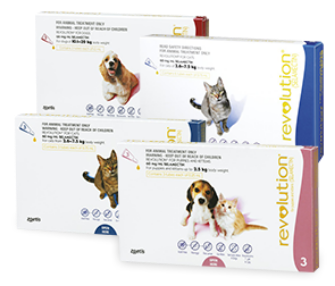

Only 5% of fleas live on your pet, the rest live in the environment. Revolution is unique because it can be effective against flea eggs and larvae in the environment as well as adult fleas on your cat, stopping the flea life cycle.
FLEAS & OTHER PARASITES
Providing Parasite Protection
Parasites aren't just a nuisance. As the cause of many diseases in cats and kittens, they are a real threat to your pets, and to you.
Fleas make your pet uncomfortable and cause flea allergy dermatitis, the most common skin allergy in cats. Fleas also transmit tapeworm to cats, not to mention the trouble a flea infestation can cause you.
To keep your cat and home environments healthy, learn how to recognise the symptoms of parasites, as well as how to prevent and treat parasite infestations.
CLICK ON A PARASITE BELOW TO LEARN MORE
FLEAS
There’s no other way to put it - fleas are blood-sucking ectoparasites (live on the skin surface of their ‘host’).
What is a flea?
Fleas are blood-sucking ectoparasites. There are 2,200 flea species known in the world today. Only a few of these commonly infest dogs and cats. Fleas are not the same as ticks.
The most common flea that affects both dogs and cats is the cat flea, or Ctenocephalides felis. It’s dark brown or black body is about one to three millimetres long. They can also feed on people, but we’re not their first choice of meal.
Why do cats get fleas?
Adult fleas have specially adapted mouth parts for piercing the skin and sucking blood. More than just annoying and irritating to your cat, they can also cause significant skin disease. Flea blood feeding is also associated with the transmission of several infectious diseases to both pets and people in New Zealand.
Fleas love warm, humid environments. And they are determined, nimble creatures capable of Olympian feats. When they're hungry and looking for a home, they can jump 10,000 times in a row up to 60 centimetres high. Plus their flat bodies allow them to move quickly through a cat's fur.
You'll usually find fleas on a cat's abdomen, the base of the tail and the head. However, a heavy infestation can thrive anywhere on the body.
What are common signs that my cat has fleas?
- You may be able to see fleas on your cat, especially if there is a large burden
- Fleas are small, and just because you don't find one on your cat, it doesn't mean that they're not there or that your cat is not being bitten by them!
- Fleas suck your cat's blood and can cause terrible skin irritation that will make your cat scratch, lick and bite themself. This may result in rashes, scaly skin, hot spots and hair loss
- Droppings, digested blood known as flea dirt, in your cat's coat
THE 4 LIFE CYCLE STAGES OF A FLEA
What do fleas do to cats?
Adult fleas have specially adapted mouth parts for piercing the skin and sucking blood. More than just annoying and irritating to your cat, it can also cause significant skin disease. Flea blood feeding is also associated with the transmission of several infectious diseases to both pets and people.
What is flea allergy dermatitis (FAD)?
It's an itchy skin disease animals develop from an allergic reaction to the saliva of fleas feeding on their blood. An affected cat will be very itchy – often from scratching, biting, licking and chewing. Their skin is usually reddened and there may be lesions and hair loss.
Infectious diseases from fleas
It's not just your cat at risk here. Fleas can carry infectious diseases that are transmitted to humans such as:
- Bartonella henselae – causes cat scratch fever
How can I treat or prevent fleas?
Products such as Revolution® can be used to treat, control and prevent flea infestations, as well as control flea allergy dermatitis.
Flea preventatives should be used year round. Your vet will be able to help you choose the right one for your cat.
WHAT IS A PARASITE?
A parasite is a plant or animal that lives on or inside another living organism (called a host). A parasite is dependent on its host and obtains a benefit, such as survival, at the host’s expense.
ARE THERE DIFFERENT KINDS OF PARASITES?
There are two basic types:
Internal parasites (endoparasites) such as roundworms live inside the body of a host cat.
External parasites (ectoparasites) such as fleas, ticks, ear mites and sarcoptic mange mites live on the body of their host cat.
HOW DANGEROUS ARE PARASITES TO MY CAT?
It depends on three things: the type of parasite, the degree of infection or infestation, and your pet’s individual reaction. A mild flea infestation may be of no great consequence to some cats, while others may show hair loss, itching and discomfort. Severe flea infestations can lead to significant skin disease, anaemia or even death, especially in young puppies. Infestations by ear mites can cause inflammation of the outer ear (i.e. ‘otitis’) that can be further complicated by secondary fungal and bacterial infections characterised by an unpleasant odour and a crusty brown discharge. Sarcoptic Mange Mites can cause severe itchiness, hair loss and discomfort. These mites can also infect humans who come into contact with affected cats.
ARE PARASITES IN MY PET A RISK TO ME OR MY FAMILY?
Parasites like roundworms can be transmitted to humans and can cause a variety of health problems including nausea, neurological problems and even blindness.
WHAT MAKES REVOLUTION THE PREFERRED PARASITE CONTROL PRODUCT?
Revolution is the first and only topical treatment to protect against a wide range of both external and internal parasites in cats. That’s what makes it so revolutionary because in the past, you needed multiple treatments that were difficult to remember, hard to use, and stressful for you and your pet.

Only 5% of fleas live on your pet, the rest live in the environment. Revolution is unique because it can be effective against flea eggs and larvae in the environment as well as adult fleas on your cat, stopping the flea life cycle.
It’s not just your dog at risk here, fleas can carry infectious diseases that are transmitted to humans too!
TREATMENT &
PREVENTION PLAN
Only 1 out of every 20 fleas affecting your cat are found on his or her body. So where are all the others? They're in and around your cat's living environments.
While Revolution is extremely effective in treating the fleas cavorting around on your cat, eradicating them and preventing them from coming back will be most effective when your cat's living areas are being treated at the same time.
-
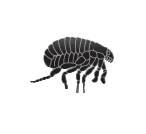 TREATMENT PLAN
TREATMENT PLAN
If there are already fleas in your cat's living spaces, this Flea Treatment Plan will help you get your house parasite-free as quickly as possible. -
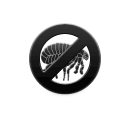 PREVENTION PLAN
PREVENTION PLAN
Now you’ve created a flea-free environment, use this Flea Prevention Plan to make sure they don’t come back.
TREATMENT PLAN
Treatment plan to create a flea-free home
To eradicate any fleas that have followed your cat back to your place and made a home for themselves there, do all of the following as thoroughly as possible:
- 1.Treat all your dogs and cats with Revolution
- 2.Vacuum lounge chairs and cushions (and bin or burn the vacuum bag immediately afterwards)
- 3.Throw out any cushions you think could have infestations
- 4.Wash pet bedding in hot water
- 5.Clean out the kennel or basket
- 6.Vacuum the car
- 7.Vacuum or wash rugs, and administer flea control treatment
- 8.Wash any household bedding in hot water at least 60° C
PDF 2.10MB

TIPS FOR A HEALTHY CAT
Although keeping them in good health is relatively easy, cats rely heavily on commitment from their owners plus regular veterinary visits.

- Just because you can’t see it, doesn’t mean it’s not there.
Have your cat examined regularly from an early age by your veterinarian, and avoid the possibility of worm infection with a preventative treatment. Once your kitten’s regular veterinary visits are complete, make sure to continue with annual check-ups – it can be easy to forget.
- 24x7x365 parasite protection
Indoor AND outdoor cats need year-round parasite protection.
- Cats need to scratch
Scratching helps shed the sheaths of your cat’s claws, stretches muscles, marks territory, and feels good, so be sure to provide appropriate scratching structures.
- Play time!
Just as with people, diet and exercise play a significant role in your cat’s health. Regular activity will help to manage weight, increase cardiovascular blood flow and maintain good health. And contrary to years of bad press, most cats do actually like to play. You might just have to be a little creative until you find exactly what kind of activities your cat likes to do.
- Name, rank and serial number
Make sure your cat has a properly fitted collar and name tag, even if it’s an indoor cat. Accidents happen and if a door is not shut properly, curiosity can prevail and your puss might wander beyond the point of no return.
- Groom regularly
Not only will you reduce hairballs, you’ll have the opportunity to examine your cat’s skin for early symptoms of disease, and for parasites such as fleas, before they become a serious problem.
- Out with the old
To keep the litter box free of odour and bacteria, empty and replace the litter regularly.
- H2-Oh!
Always keep fresh drinking water available in a clean bowl. Water is an essential ingredient for good health and is involved in virtually every function of your cat’s body.





